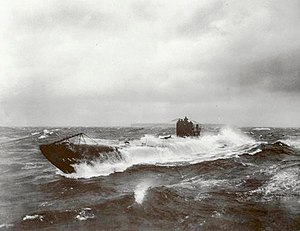 UB-148 at sea, a U-boat similar to UB-145.
| |
| History | |
|---|---|
| Name | UB-145 |
| Ordered | 27 June 1917[1] |
| Builder | AG Weser, Bremen |
| Cost | 4,301,000 German Papiermark |
| Yard number | 311 |
| Laid down | 15 April 1918[2] |
| Launched | October 1918[3] |
| Completed | 27 March 1919[3] |
| Fate | Surrendered 27 March 1919; sold for scrap 22 July 1920; hulk dumped in Medway estuary 1922 |
| General characteristics [3] | |
| Class and type | Type UB III submarine |
| Displacement | |
| Length | 55.85 m (183 ft 3 in) (o/a) |
| Beam | 5.80 m (19 ft) |
| Draught | 3.85 m (12 ft 8 in) |
| Propulsion |
|
| Speed |
|
| Range |
|
| Test depth | 50 m (160 ft) |
| Complement | 3 officers, 31 men[3] |
| Armament |
|
| Service record | |
| Operations: | No patrols |
| Victories: | None |
UB-145 was a German Type UB III submarine or U-boat built for the German Imperial Navy (German: Kaiserliche Marine) during World War I. Incomplete at the end of the war, she was surrendered to the Allies at Harwich on 27 March 1919, and then taken to Chatham Dockyard as a potential subject for experimental work, but was never so-employed.[4] She was sold to M. Lynch & Sons on 22 July 1920 for £2,000, and towed to Rochester, Kent. After being stripped of any reusable material, the hulk was dumped in shallow water in the Medway estuary, along with those of UB-144 and UB-150. The remains of all three - partly broken up in-situ during 1939–45, with one significantly better preserved than the other two - remain visible, but it is unclear which wreck is which.[5]
- ^ Rössler 1979, p. 56.
- ^ Helgason, Guðmundur. "WWI U-boats: UB 145". German and Austrian U-boats of World War I - Kaiserliche Marine - Uboat.net. Retrieved 13 February 2009.
- ^ a b c d Gröner 1991, pp. 25–30.
- ^ Dodson, Aidan; Cant, Serena (2020). Spoils of War: the fate of enemy fleets after the two World Wars. Barnsley: Seaforth. pp. 18, 51, 130. ISBN 978-1-5267-4198-1.
- ^ Dodson and Cant, pages=100–101